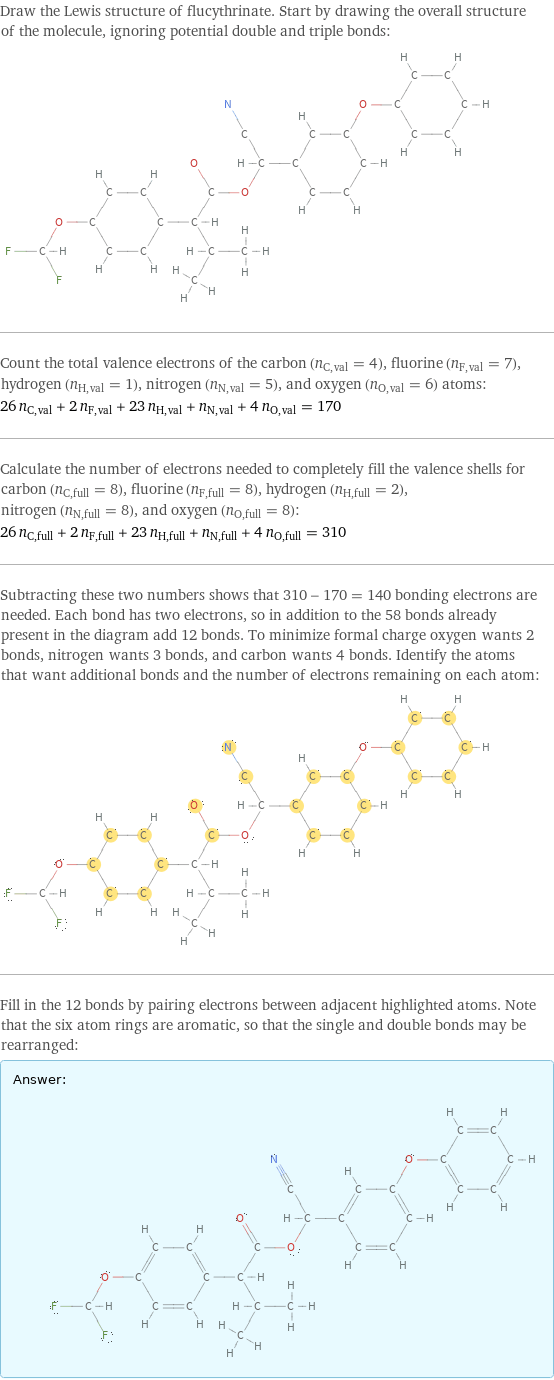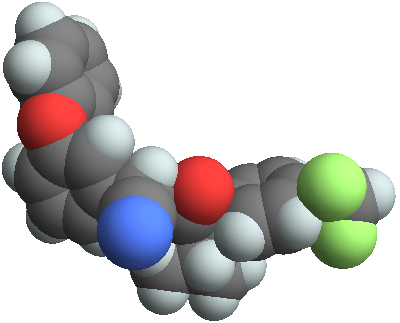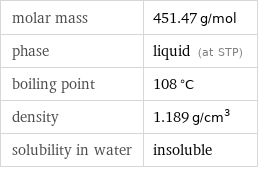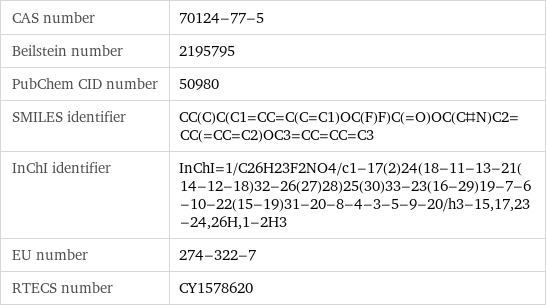Input interpretation

flucythrinate
Chemical names and formulas
![formula | C_26H_23F_2NO_4 name | flucythrinate IUPAC name | [cyano-(3-phenoxyphenyl)methyl] 2-[4-(difluoromethoxy)phenyl]-3-methyl-butanoate alternate names | cy bolt | fluorocythrin | pay-off mass fractions | C (carbon) 69.2% | F (fluorine) 8.42% | H (hydrogen) 5.14% | N (nitrogen) 3.1% | O (oxygen) 14.2%](../image_source/cb8ad3fd4d68fe711ffc2dbdb31f709b.png)
formula | C_26H_23F_2NO_4 name | flucythrinate IUPAC name | [cyano-(3-phenoxyphenyl)methyl] 2-[4-(difluoromethoxy)phenyl]-3-methyl-butanoate alternate names | cy bolt | fluorocythrin | pay-off mass fractions | C (carbon) 69.2% | F (fluorine) 8.42% | H (hydrogen) 5.14% | N (nitrogen) 3.1% | O (oxygen) 14.2%
Lewis structure

Draw the Lewis structure of flucythrinate. Start by drawing the overall structure of the molecule, ignoring potential double and triple bonds: Count the total valence electrons of the carbon (n_C, val = 4), fluorine (n_F, val = 7), hydrogen (n_H, val = 1), nitrogen (n_N, val = 5), and oxygen (n_O, val = 6) atoms: 26 n_C, val + 2 n_F, val + 23 n_H, val + n_N, val + 4 n_O, val = 170 Calculate the number of electrons needed to completely fill the valence shells for carbon (n_C, full = 8), fluorine (n_F, full = 8), hydrogen (n_H, full = 2), nitrogen (n_N, full = 8), and oxygen (n_O, full = 8): 26 n_C, full + 2 n_F, full + 23 n_H, full + n_N, full + 4 n_O, full = 310 Subtracting these two numbers shows that 310 - 170 = 140 bonding electrons are needed. Each bond has two electrons, so in addition to the 58 bonds already present in the diagram add 12 bonds. To minimize formal charge oxygen wants 2 bonds, nitrogen wants 3 bonds, and carbon wants 4 bonds. Identify the atoms that want additional bonds and the number of electrons remaining on each atom: Fill in the 12 bonds by pairing electrons between adjacent highlighted atoms. Note that the six atom rings are aromatic, so that the single and double bonds may be rearranged: Answer: | |
3D structure

3D structure
Basic properties

molar mass | 451.47 g/mol phase | liquid (at STP) boiling point | 108 °C density | 1.189 g/cm^3 solubility in water | insoluble
Units

Liquid properties (at STP)

density | 1.189 g/cm^3
Units

Chemical identifiers

CAS number | 70124-77-5 Beilstein number | 2195795 PubChem CID number | 50980 SMILES identifier | CC(C)C(C1=CC=C(C=C1)OC(F)F)C(=O)OC(C#N)C2=CC(=CC=C2)OC3=CC=CC=C3 InChI identifier | InChI=1/C26H23F2NO4/c1-17(2)24(18-11-13-21(14-12-18)32-26(27)28)25(30)33-23(16-29)19-7-6-10-22(15-19)31-20-8-4-3-5-9-20/h3-15, 17, 23-24, 26H, 1-2H3 EU number | 274-322-7 RTECS number | CY1578620
Toxicity properties

RTECS classes | agricultural chemical and pesticide